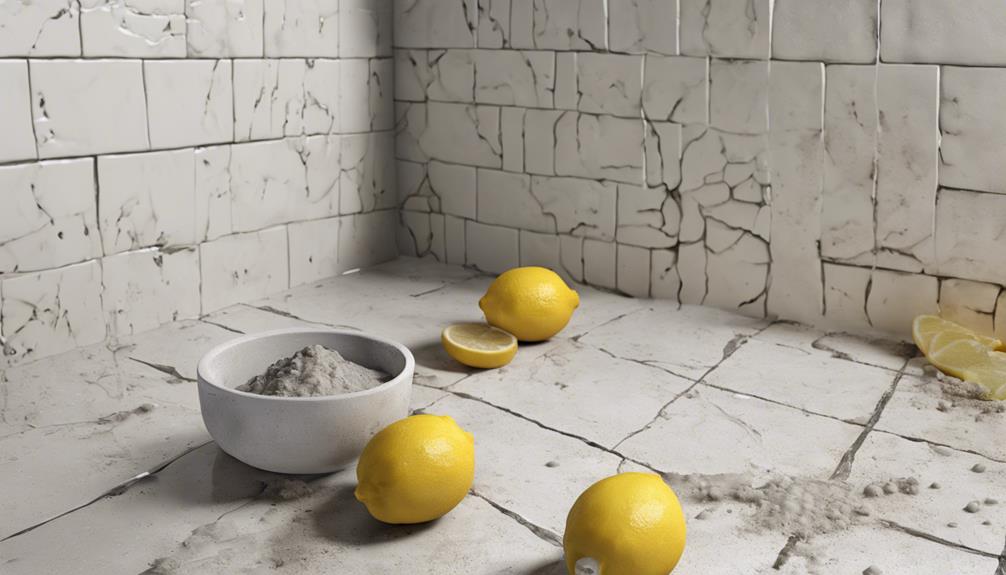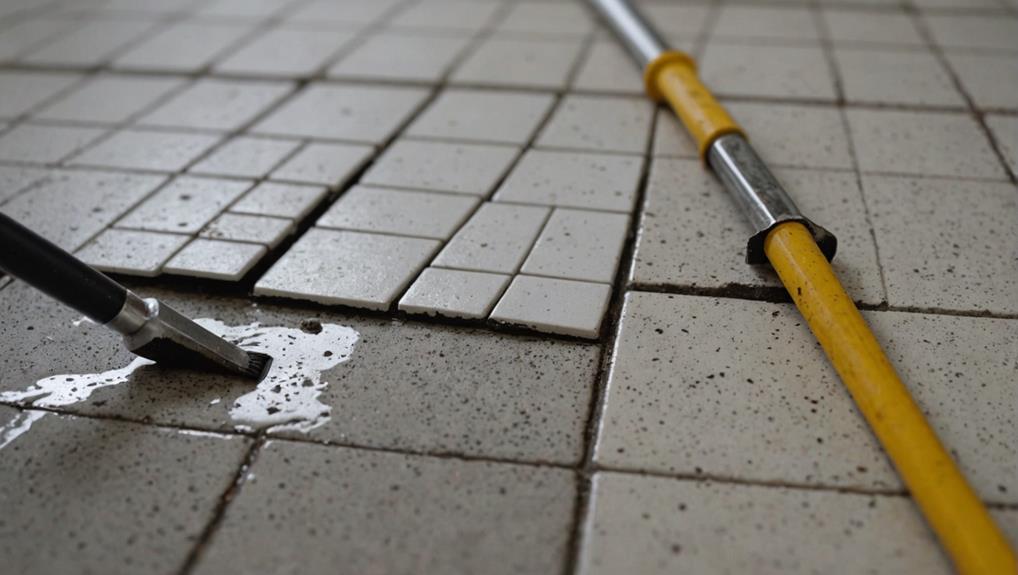When it comes to cleaning your grout, you’ll want to use the right techniques and tools to effectively remove dirt and grime. Start by selecting a suitable cleaning solution, such as a natural combination of vinegar and baking soda or hydrogen peroxide, which can be applied using a stiff-bristled brush or spray bottle. For tougher stains, consider using a steam cleaner with a grout brush attachment. Additionally, wearing protective gloves and ensuring good ventilation are essential safety precautions. By following these methods and taking necessary safety measures, you’ll be well on your way to achieving clean, streak-free grout lines – and uncovering even more secrets to maintaining a sparkling clean home.
Key Takeaways
- Use a stiff-bristled brush and natural cleaning solutions like vinegar and baking soda to effectively remove dirt and grime from grout lines.
- Steam cleaning is an eco-friendly method that loosens dirt and grime without damaging tile or grout, and can be used with natural cleaning solutions for added effectiveness.
- Mixing hydrogen peroxide and dish soap creates a solution that kills bacteria and removes tough stains from grout, making it a great alternative to harsh chemicals.
- Regular maintenance, such as cleaning up kitchen spills immediately, is key to preventing dirt and grime buildup and making grout cleaning easier and more effective.
Understanding Grout Types
You’ll need to choose the right type of grout for your specific project, as different formulations cater to various joint sizes, levels of moisture, and amounts of traffic.
Sanded grout, made with cement and grit, is ideal for larger joints (over 1/4 inch wide), while unsanded grout, also made with cement but without grit, is better suited for narrower joints (as small as 1/16 inch wide).
Epoxy grout, on the other hand, is a top choice for areas prone to high moisture, as it holds up well to water stains and is less susceptible to shrinking or sagging.
Traditional cement grout, the most common type, is suitable for most tile installations but requires proper sealing to prevent staining and water damage.
Some grouts are precolored and contain polymers, offering enhanced moisture and mildew resistance, making them perfect for areas like bathrooms and kitchens.
Essential Cleaning Tools
Effective grout cleaning requires a strategic arsenal of specialized tools, each designed to tackle the unique challenges of dirt and grime embedded in grout lines.
You’ll need a stiff-bristled brush to scrub away dirt and grime, especially when using cleaning solutions like vinegar and baking soda or hydrogen peroxide.
A spray bottle is also essential for evenly distributing cleaning solutions to grout lines.
If you’re dealing with tough stains, consider using a steam cleaner to loosen dirt and grime without damaging the tile or grout.
For added protection and grip, wear grout cleaning gloves when using harsh chemicals or abrasive cleaners.
To take your cleaning to the next level, use a grout brush attachment with your steam cleaner to scrub away dirt and grime.
Or you can make your life easier by using a pool cleaning robot.
With these tools in your arsenal, you’ll be well-equipped to tackle even the toughest grout cleaning tasks.
Natural Cleaning Solutions

Mixing vinegar and baking soda creates a potent natural cleaning solution that scrubs away dirt and grime from grout lines, offering an eco-friendly alternative to harsh chemical-based cleaners.
This solution isn’t only effective but also chemical-free, making it a great option for homeowners who want to avoid harsh chemicals.
You can also use hydrogen peroxide, a natural disinfectant that kills bacteria and removes tough stains from grout.
Another alternative is oxygen bleach, a safe and non-toxic substitute for chlorine bleach that removes stains, dirt, and grime from grout without damaging the surrounding tile or grout lines.
These natural cleaning solutions can be used in combination with steam cleaning for an even more effective and environmentally friendly grout cleaning method.
By using these natural cleaning solutions, you’ll be able to achieve a deep clean without exposing yourself or the environment to harsh chemicals.
With these eco-friendly options, you can rest assured that your grout cleaning process isn’t only effective but also sustainable.
Effective Grout Cleaning Methods
When tackling grout cleaning, it’s crucial to employ methods that not only remove dirt and grime but also guarantee the integrity of the surrounding tile and grout lines.
You’ll find that steam cleaning is an effective and eco-friendly method, using steam to loosen dirt and grime without damaging the tile or grout lines.
Alternatively, you can mix baking soda and vinegar to create a natural cleaning solution that effectively removes dirt and grime from grout.
For tougher stains, combine hydrogen peroxide and dish soap to create a solution that kills bacteria and removes tough stains from grout.
If you’re looking for a safe and non-toxic alternative to chlorine bleach, oxygen bleach is an excellent option.
When it comes to grout cleaning methods, it’s imperative to choose the right solution for the job.
While grout cleaning pens may seem like a convenient option, they only cover dirt and stains rather than removing them, making them less effective than other methods.
Maintenance and Safety Precautions

As you’ve successfully employed effective grout cleaning methods, it’s now important to maintain your grout’s cleanliness and take necessary safety precautions to guarantee a healthy and safe environment.
Regular maintenance is key to preventing dirt and grime buildup, making it easier to clean and maintain a clean home.
To certify your safety while cleaning, always follow directions and wear rubber or nylon gloves to protect your hands from harsh chemicals and abrasive materials.
Additionally, confirm adequate ventilation when using strong cleaning products to prevent inhaling harmful fumes and reduce the risk of respiratory problems.
When cleaning, remember to clean up kitchen spills immediately to prevent stains from setting and make grout cleaning easier and more effective.
Frequently Asked Questions
How Do You Remove Ingrained Dirt From Grout?
You remove ingrained dirt from grout by using specialized tools like grout scrubbers, grout brushes, and grout steamers, along with dirt solvents, vinegar solutions, and baking soda, and finishing with grout sealers to prevent future dirt buildup.
How Do You Clean Severely Dirty Grout?
You’ll need to employ deep scrubbing, grout steaming, or heavy chemicals to tackle severely dirty grout; afterwards, consider grout sealing and regular maintenance to prevent future buildup, or opt for professional cleaning, tile cleaning, or even grout replacement if necessary.
How Do You Get Ground in Dirt Out of Grout?
As you tackle old grout, coincidentally, you’ll notice dirt particles clinging to the grout texture, especially in dirty corners and stained areas. You’ll need to use grout cleaners that penetrate deep into the grout pores to remove everyday dirt, making regular maintenance a fresh cleaning habit.
What Lifts Dirt From Grout?
You’ll find that grout abrasives, dirt solvents, and enzyme cleaners effectively lift dirt from grout, while grout brushes, water pressure, and heat application enhance their performance, and clay absorbers, ultrasonic cleaning, and acid treatments offer alternative solutions.
Conclusion
You’ve made it to the end of this grout-cleaning guide, and now your tiles should be sparkling!
Did you know that the average American spends around 2 hours a week cleaning?
With these effective methods, you’ll be able to tackle grout dirt in no time, freeing up more time for the things you love.
By following these steps and using the right tools and solutions, you’ll be a pro at keeping your grout clean and your home looking its best.

I’m Max, the founder and chief pool enthusiast behind Pool Pro Tips. As a passionate pool owner and cleaning expert, I created this website to share my knowledge and experience with you, helping you to keep your pool sparkling clean and safe for years to come.

